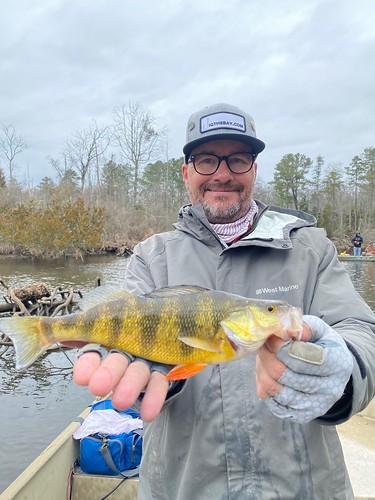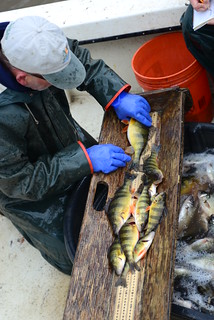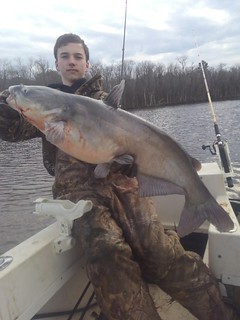Maryland Fishing Report – March 4
There are many different signs of spring that we notice — for some, it might be the first blooming daffodil or spotting the first osprey. One of the most popular harbingers of spring in Maryland for anglers is the much anticipated yellow perch spawning runs that occur in many of the Chesapeake Bay’s tributaries this month. Those spawning runs are underway and should peak within the next week.
This should be a very good year for Maryland anglers based on the Maryland Department of Natural Resources survey results. Fisheries biologist Paul Piavis reports that the 2011 year class of yellow perch was a strong one, and those perch will measure 13 inches or more this year. He also reports a strong 2015 year class, and those perch will measure 10 inches or better, followed by a strong 2014 year class.
Yellow perch fillets are a real treat and are often fried. If you have a pre-spawn yellow perch, try and find a home for the roe, which many people enjoy eating.
There are a few different ways to fish for yellow perch based on where they are holding. In the more open waters, they tend to hold in deep channels before they get the urge to spawn and ascend the tidal rivers. Fishing with enough weight to hold bottom and a two-hook bottom rig baited with small minnows, grass shrimp, or perhaps small jigs is a good way to catch them.
As the yellow perch move far up the rivers and into small and more confined waters, fishing with ultra-light tackle is the name of the game. Casting small shad darts, beetle spins, and small grub-type jigs is a fun way to catch them. Fishing small minnows and grass shrimp on a small shad dart or a bait hook is also very effective. Thin, low-poundage braid line with a 4- to 6-pound fluorocarbon leader is a real asset for casting light jigs — some can be as light as a 1/32 ounce. It also pays to have a lightweight fluorocarbon leader to break off from snags. There usually are a lot of hidden submerged branches and tree limbs in the more confined waters that tend to gobble up anglers’ lures.
When fishing with lightweight jigs, it pays to cast slightly upstream and walk the jig along the bottom in a sweeping motion, keeping a slight belly in your line to detect twitches that indicate a strike. Placing a little piece of red felt that has few dabs of anise or your favorite fish attractant can also provide an advantage. A small section of fresh minnow placed on the shad dart hook is one of my favorites, especially when the action is hot and heavy and you’re watching your bait supply evaporate.
Keep an eye on fishing conditions. Check the tide tables listed on the department website for where you want to fish – a low flood tide is best. Generally, 46 degrees is when yellow perch feel the urge to move into the spawning areas, and once the water hits 48 degrees it is on. The run can happen fairly quickly, often at night, and once it is over the post-spawn yellow perch depart quickly. Anglers who arrive late are often greeted with, “you should have been here yesterday, you really missed it.”
Forecast Summary: March 4-10
As we approach the beginning of spring, expect air temperatures to first cool through Saturday and then warm through next Tuesday. There will be windy conditions on Friday night and Saturday along with a chance of rain on Friday and again early next week. These typical March conditions will continue to warm Maryland bay waters for gamefish.
As reported from the NOAA buoys, main bay surface water temperatures are holding in the low 40s. However, smaller streams and downwind areas on a sunny day will warm faster and will often hold water temperatures in the upper 40s. Low salinity areas in this range will be prime areas to look for spawning yellow perch. In the main bay, there are still slightly warmer bottom waters so anglers may want to scan these areas for other gamefish.
The Maryland portion of the bay continues to have suitable oxygen conditions from surface to bottom. Bay surface salinities are normal for this time of year. Expect reduced water clarity in the upper bay from the Aberdeen area to Swan Point, and on the Potomac River downstream to near the 301 Bridge.
Expect normal flows to the rivers and streams entering they bay. There will be above average tidal currents conditions from Friday through next Tuesday as a result of the full moon March 10.
For the full weekly fishing conditions summary and more detailed and up-to-date fishing conditions in your area of the bay, be sure to check out Click Before You Cast. Get regular updates on Maryland’s waters sent to your inbox with our Eyes on the Bay newsletter. Sign up online.
The deeper parts of the lower Susquehanna River in the Perryville area below the Railroad Bridge has been providing good fishing for yellow perch. When fishing from boats, most are using dropper rigs with enough weight to get down to the bottom. A two-hook rig baited with small minnows or grass shrimp has been the most popular way to fish for the yellow perch.
The Northeast River may see good yellow perch action before the weekend if warm weather continues this week. The North East Community Park is a very good place to fish from the shoreline and the floating docks.
A little farther down the bay, the Bush River in the region of Route 40 and also Winters Run are usually good places to find yellow perch. Keep in mind that the western shore tributaries often run warmer than tributaries on the eastern side of the bay at the same latitude.
The Chester River is another good place to fish for yellow perch; anglers often intercept them from Chestertown upriver to Millington. The Sassafras River also has a yellow perch run — the area from Georgetown to the town of Sassafras offers popular places to fish.
Anglers may begin to see some white perch in the lower to middle sections of the region’s tidal rivers. Often they will be found deep as they stage for their spawning runs later on this month. Fishing bottom rigs baited with pieces of bloodworms has been the best way to entice them to bite.
There are plenty of blue catfish to be caught in the upper bay region and the lower Susquehanna, Elk and Sassafras rivers. Every January and February, the department conducts an upper bay winter trawl of 23 sites in the bay from Tolchester to Turkey Point and sites in the Elk, Sassafras. and Chester rivers. Among other resident species sampled, the catches of blue catfish provided some startling results. At first one or two blue catfish showed up the trawls from 2011 to 2018, then rose to 28 in 2019. Preliminary 2020 results show captures rose to 2,647, with some measuring 28 inches. So far no blue catfish have been found in the Chester River during the surveys.
Fishing with fresh cut bait of gizzard shad, white perch, or other favorite baits are an excellent way to catch blue catfish and also channel catfish. Just below the Railroad Bridge on the lower Susquehanna has been a very productive place to fish this week. Flathead catfish can be found at the Conowingo Dam Pool and downriver. The largest flathead catfish tend to be in the dam pool; smaller ones are spread throughout the lower section of the river.
Most eyes are focused on the Choptank, Nanticoke, and Severn rivers this week. Yellow perch are staging below the spawning areas in the upper reaches of the rivers and major creeks that flow into them. Surface water temperatures of 48 degrees was reported on the Tuckahoe at Hillsboro and below Denton on the Choptank River. Yellow perch survey crews reported yesterday that 40 percent of the female yellow perch sampled below Denton had spawned, but farther down the river almost 100 percent of the female yellow perch had not spawned yet. They also reported that most of the yellow perch measured 11 inches or more in length.
The Marshyhope Creek has been a great place to catch yellow perch from the mouth of the creek all the way upstream to Federalsburg. Most are fishing with bottom rigs baited with minnows or grass shrimp or working small jigs along the bottom.
There are lots of blue catfish in the Nanticoke River and lower Marshyhope Creek and they can provide plenty of easy and fun fishing action. The area of the Nanticoke around Sharptown tends to be the center of it all and fishing the deeper holes in the river with fresh cut bait will get you into the action. Recent surveys in the Nanticoke are showing extremely large numbers of juvenile blue catfish indicating that the population is exploding. They are a fierce predator at any size and their expansion does not bode well for the health of a diverse fishery. The Choptank River has blue catfish also and is playing catchup with the Nanticoke River in regard to population density and the size of the catfish.
Several tidal rivers in the lower bay are offering good fishing for yellow perch. The area from Jug Bay to Wayson’s Corner on the Patuxent River is traditionally a great place to fish for yellow perch. The Pocomoke and Wicomico rivers on the Eastern Shore are holding yellow perch and anglers have been catching large white perch in the lower Pocomoke channels for more than a month. Small minnows and grass shrimp work well for yellow perch and pieces of bloodworm or grass shrimp will catch white perch.
Many of the tributaries to the Potomac River offer good fishing for yellow perch. The Wicomico River near Allen’s Fresh and Route 234 is a traditional location to find spawning yellow perch. Mattawoman and Manokin creeks also have spawning runs of yellow perch.
Blue catfish are very abundant in the tidal Potomac and Patuxent rivers and are providing nonstop fishing action for those fishing for them. The largest blue catfish can exceed 80 pounds and can be found in the deepest channel areas of the Potomac. The channels off Fort Washington are one of the most popular places to catch the largest ones. The smaller blue catfish can be found in shallower areas along the channel edges and make fine table fare. Fresh cut bait of gizzard shad or most any other allowable fish such as bluegills sunfish, white perch, goldfish, or golden shiners make excellent baits.
The 2020 Youth Fishing Rodeo schedule is now available online and this is a good time to mark some of the dates on your calendar for a location near you. If you have a first-time youth angler, it is never too early to let them pick out a fishing outfit that they like and practice casting in the backyard or local pond. Kids can pick out push-button spin outfits in cartoon, princess, or superhero themes, which are usually a big hit.
The stocking crews are busy distributing trout from the hatcheries this week, providing plenty of fun fishing at a wide variety of areas ranging from community ponds to picturesque mountain creeks and rivers. This is a wonderful time to fish for trout, so be sure to check out the trout stocking website to see which waters close to you have been stocked.
Fisheries biologist John Mullican reports the mild winter and favorable river flows this year has given anglers ample opportunities to chase smallmouth bass and walleye on the upper Potomac. Yes, smallmouth bass recruitment has been down in recent years, mainly due to high spring flows, and that has reduced catch rates. There are still nice bass to catch, however. A mobile approach is recommended to find where the bass are. This is particularly important as spring progresses and the bass begin moving from wintering habitat to spawning habitat. Check online to see what the department is doing to improve upper Potomac River bass fishing. You can also check the Potomac River smallmouth bass stocking program website.
The stocked put-and-take areas are great places to fish with artificially flavored dough baits or good old garden worms. Casting small spinners or spoons can cover a lot of water when looking for trout that have spread out days after the initial stockings, or at sites that have been float stocked. The latter is when volunteer crews will float down a stretch of river in a small boat, dispersing the trout carried alongside in a floating live box over a wide area.
Crappie are holding in 5 feet or 6 feet of water near most any kind of structure they can find. Bridge piers, marina docks, fallen treetops, and sunken structure is where you’ll find them. Tidal rivers, farm ponds, and reservoirs are all good places to look for them this time of the year. Small minnows or marabou jigs under a slip bobber are one of the best ways to catch them.
Largemouth bass are becoming active and are moving to shallower waters between the deeper drop-offs and the shallower areas where grass will emerge in the next month or so. Structure is a magnet to the bass and submerged wood is an enticing attractant. Working a variety of grubs, jigs, and small crankbaits in these transition areas is a great way to fish. Sunny afternoons will often beckon largemouth bass to move into shallow and warmer waters. Spinnerbaits, jerkbaits are a good choice to fish these areas.
It is still a little cold for northern snakeheads but they should start to kick in gear by the end of the month. In the meantime casting white grub type lures or fishing large minnows behind a bobber or popping cork is a good way to get things started. Chain pickerel do not mind cold water at all and seem to rejoice in it this time of the year. They are very active and will attack a variety of lures cast near structure.
The tautog fishing off Ocean City has been very good and for some anglers they’ve had trips they’ll never forget. Finding tautog willing to bite — and finding exceptionally large ones — is always a challenge for charter and party boat captains. Weather plays a big part in boats being able to venture out to the wreck and reef sites and then there are fickle currents. If tautog are on your mind, don’t miss some of the fishing opportunities available this month.
The recreational striped bass size and catch limits for the Atlantic Ocean, coastal bays and their tributaries has been announced. Recreational anglers may keep one striped bass per person per day. The striped bass must be a minimum of 28 inches and may not exceed 35 inches in length. This action is necessary to implement the Atlantic States Marine Commission’s Interstate Fishery Management Plan for striped bass.
“There are two distinct kinds of visits to tackle shops — the visit to buy tackle and the visit which may be described as Platonic when, being for some reason unable to fish, we look for an excuse to go in and waste a tackle shop dealer’s time.“– Arthur Ransome
Maryland Fishing Report is written and compiled by Keith Lockwood, Maryland Department of Natural Resources fisheries biologist. Fisheries biologists John Mullican and Paul Piavis contributed to this report.
Click Before You Cast is written by Tidewater Ecosystem Assessment Director Tom Parham.
This report is now available on your Amazon Echo device — just ask Alexa to “open Maryland Fishing Report.”







 1-888-373-7888
1-888-373-7888 233733
233733